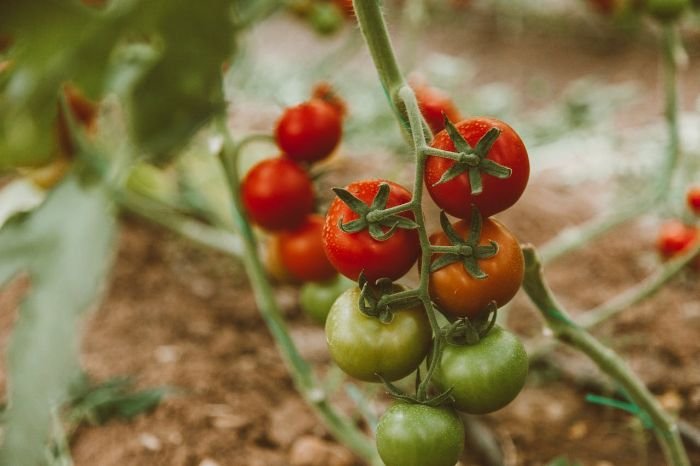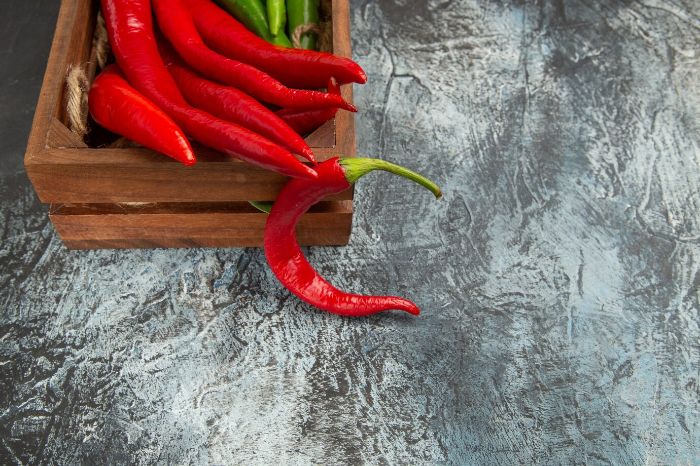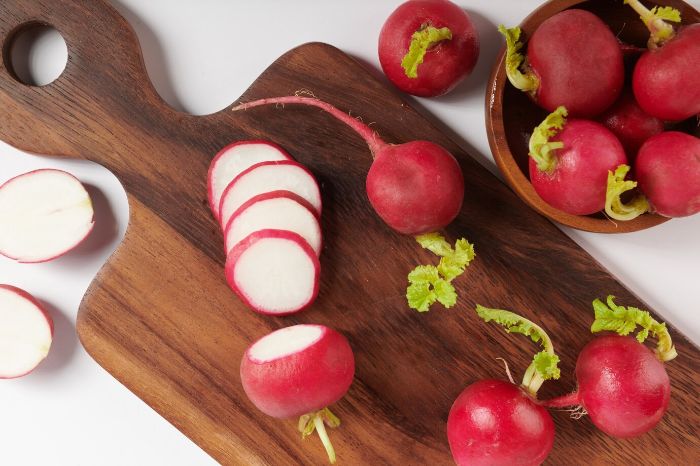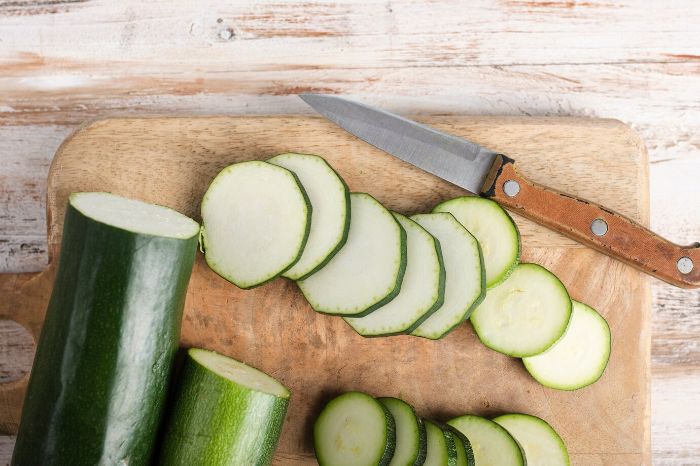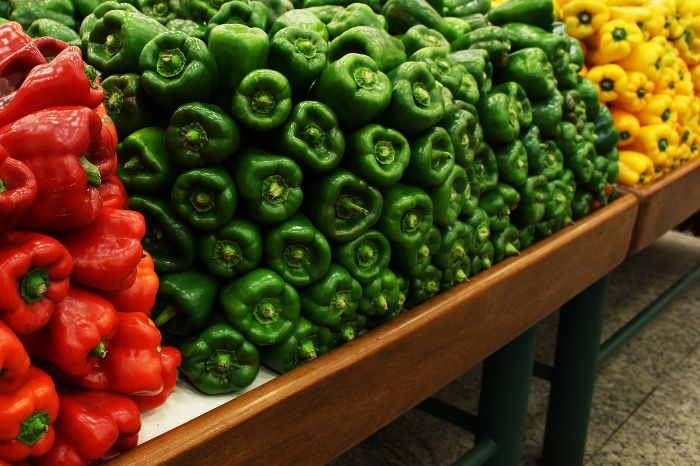Tomato plants progress through distinct developmental stages – each with specific needs and signs that guide proper care. From the moment a seed germinates to the harvest of fully ripened fruit, knowing what to expect at every phase gives you better control over plant health and productivity. This guide outlines each stage and explains how to support your plants effectively at every step.
Key Takeaways:
- Tomato growth follows a clear sequence: germination, seedling, vegetative, flowering, fruiting, and ripening.
- Each stage has unique requirements for temperature, water, light, and nutrients.
- Recognizing stage-specific needs helps prevent issues and optimize yield.
- Timely interventions, such as transplanting, pruning, or adjusting fertilization, support healthier development.
- Understanding the full growth cycle improves harvest quality and consistency.
Table of Contents
Germination Stage – How to Start Tomato Seeds Successfully
The germination stage marks the beginning of a tomato plant’s life cycle, where seeds awaken and start developing into seedlings. This foundational phase directly influences the strength and productivity of the mature plant. Successful germination depends on creating favorable environmental conditions and applying precise sowing and early care practices, both of which set the stage for vigorous growth ahead.
Optimal Conditions for Seed Germination
Tomato seeds germinate best in warm, consistently moist conditions with adequate airflow. Ideal soil temperatures range from 65°F to 85°F (18°C to 29°C). To maintain steady humidity, lightly mist the soil or cover trays with a humidity dome or plastic wrap – removing it daily for ventilation. Proper air circulation prevents fungal problems like damping-off, which can quickly destroy young seedlings. Warmth, moisture, and airflow must work in balance for strong, uniform germination.
How to Sow Tomato Seeds and Care for Young Seedlings
To ensure successful germination, begin with high-quality seeds and nutrient-rich soil – ideally amended with compost or aged manure. Sow seeds ¼ to ½ inch (0.6–1.2 cm) deep and cover lightly with fine soil. Water gently using a spray bottle or fine-rose watering can to avoid displacing seeds. Keep trays in a warm area with indirect light and consistent moisture. Once germinated, seedlings need bright light, either from a south-facing window or full-spectrum grow lights, to prevent weak, leggy growth.
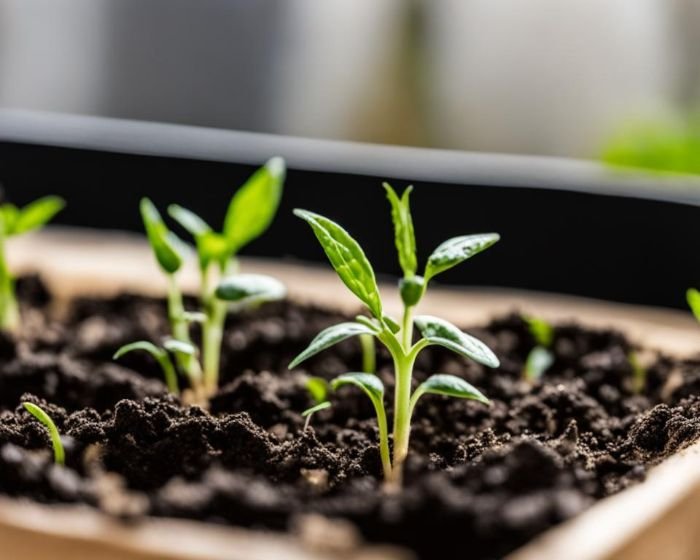
Seedling Stage – How to Grow Strong, Healthy Tomato Plants
The seedling stage is pivotal for tomato plants, as they establish strong root systems and develop their first true leaves. Proper care at this point shapes the plant’s long-term vigor, resilience, and future yield. Investing attention during this stage builds the foundation for healthy, productive growth throughout the entire life cycle.
Light, Water, and Temperature Requirements for Healthy Tomato Seedlings
To support vigorous growth during the seedling stage, tomato plants require precise control of light, water, and temperature:
- Light – Seedlings need 6 to 8 hours of strong, direct sunlight daily. Indoors, position them under full-spectrum fluorescent or LED grow lights placed close enough to prevent stretching but far enough to avoid scorching.
- Water – Maintain evenly moist soil without saturating it. Water at the base of the seedlings to keep foliage dry, minimizing the risk of fungal infections like damping-off.
- Temperature – Keep temperatures between 65°F and 85°F (18°C to 29°C) for optimal growth. Protect seedlings from cold drafts and temperature swings. Indoors, a seedling heat mat can help maintain steady warmth, especially during early spring sowing.
Solving Common Problems During the Tomato Seedling Stage
Despite your best efforts, tomato seedlings may encounter challenges. Recognizing early warning signs and responding correctly is key to preserving plant health:
- Overwatering – Excess moisture can suffocate roots and trigger fungal infections. Always use well-draining soil and water only when the top inch feels dry to the touch.
- Under-watering – Inconsistent watering stresses seedlings, leading to wilting and stunted growth. Maintain steady soil moisture, adjusting based on temperature and container size.
- Damping-off disease – This lethal fungal disease attacks at the soil line. Prevent it by using sterile potting mix, providing airflow, and avoiding overcrowding.
- Leggy growth – Thin, weak stems indicate insufficient light. Position seedlings closer to a bright light source or use supplemental grow lights to encourage strong, compact development.
When you meet the specific light, moisture, and temperature needs of your seedlings, and respond quickly to early problems, you lay the foundation for vigorous, disease-resistant plants. Careful attention during this stage directly influences the strength and productivity of your tomatoes later in the season.
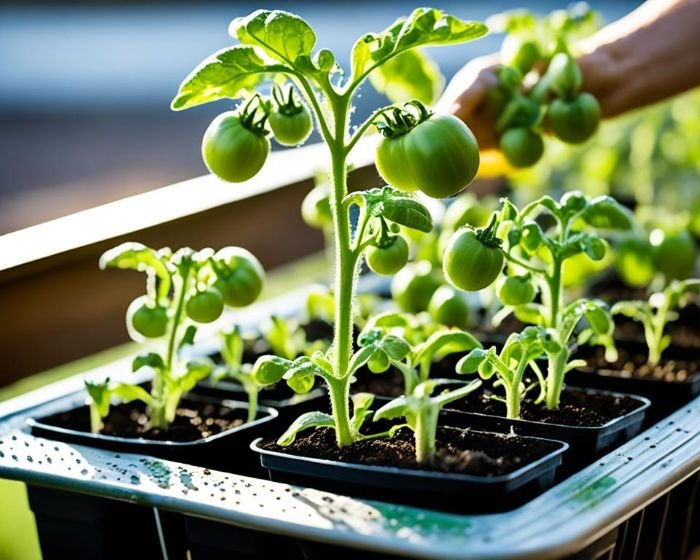
Vegetative Stage – Transplanting, Feeding, and Preparing for Flowering
During the vegetative stage, tomato plants shift their focus from root establishment to vigorous top growth. Leaf production accelerates, stems thicken, and the plant rapidly expands in size. This is the time to provide ample space, nutrients, and environmental support to help the plant build strength before entering the flowering and fruiting stages.
When and How to Transplant Tomato Seedlings Outdoors or Into Larger Pots
As tomato plants outgrow their starter containers, transplanting becomes necessary. Moving them to larger pots or into the garden gives roots the room they need to expand and access nutrients efficiently. Delaying transplanting risks root-bound plants, which often results in stunted growth.
When planting outdoors, choose a sunny, sheltered location with loose, well-draining soil. Dig a hole slightly deeper than the root ball, set the seedling in, and backfill gently. Water thoroughly to help roots settle. To prevent transplant shock, harden off seedlings by gradually introducing them to outdoor conditions over 7–10 days.
Tip: To avoid transplant shock, begin hardening off seedlings by exposing them to outdoor conditions for increasing periods over 7 to 10 days before planting them out.
Feeding and Pruning Tomato Plants During the Vegetative Stage
To fuel rapid growth during the vegetative stage, tomato plants benefit from a nitrogen-rich fertilizer that supports strong leaf and stem development. Apply fertilizer according to the product label, or adjust based on your soil type and tomato variety. Overfeeding can result in excessive foliage at the expense of future fruiting, so moderation is key.
Alongside feeding, strategic pruning helps improve structure and airflow. Remove “suckers”, the shoots that sprout between the main stem and leaf branches, to focus energy on the central stem and reduce disease pressure. Early pruning also trains the plant for better support and fruit distribution later on.
Flowering Stage – Boosting Pollination and Prepping for Fruit Set
The flowering stage signals that your tomato plants are ready to begin the transition from vegetative growth to fruit production. At this point, blossoms form at key nodes, marking the start of the reproductive cycle. While visually appealing, these flowers are functionally critical, they enable pollination, which directly affects fruit yield and quality.
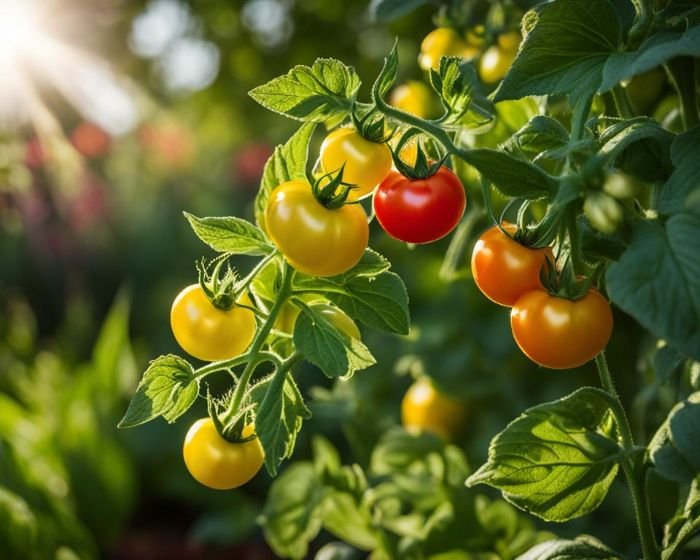
How to Improve Tomato Pollination for a Higher Fruit Set
Tomatoes are self-pollinating, meaning each flower contains both male and female reproductive parts. However, natural pollination still benefits from movement – either by wind or visiting insects. Encouraging pollinators like bees improves pollen transfer and helps increase fruit set. You can also gently shake the plant or tap flower clusters to mimic natural movement, especially when growing indoors or in low-pollinator environments.
Optimizing Watering and Fertilization for Tomato Fruit Set
As tomato plants shift into the flowering stage, fine-tuning watering and fertilization becomes critical for healthy fruit development. Water deeply but infrequently to promote deep root systems, and avoid overwatering, which can trigger root rot or dilute nutrient uptake. Always check soil moisture before watering.
For fertilization, shift to a balanced or slightly phosphorus-rich formula designed for fruiting plants. Follow label instructions precisely – overfertilizing encourages excessive foliage at the cost of fruit production. Prioritizing deep roots and targeted nutrition during flowering helps maximize both yield and fruit quality.
Fruiting Stage – Supporting Healthy Tomato Growth and Ripening
The fruiting stage marks the shift from flower production to visible fruit development – a key phase where care directly influences yield, flavor, and fruit quality. To guide your tomatoes through this stage, maintain consistent moisture, provide balanced nutrition, and support the growing plants to maximize fruit yield and quality.
Watering and Nutrition
Keep soil evenly moist, avoiding both drought stress and waterlogging. Inconsistent watering can cause blossom end rot or fruit cracking. Feed plants with a balanced tomato fertilizer containing nitrogen, phosphorus, and potassium – adjusting frequency based on plant response and soil fertility. According to recent findings on physiological responses during fruit development, environmental stressors at this stage can significantly impact fruit size, flavor, and structural integrity.
Physical Support
Prevent fruits from resting on the ground by staking, caging, or tying the plants. Supporting the vines not only protects the fruit from pests and soil-borne diseases but also improves airflow, reducing the risk of fungal infections.
Pest Monitoring
During fruiting, check plants daily for common pests like aphids, whiteflies, and tomato hornworms. At first signs, use organic methods such as handpicking or insecticidal soap to prevent population spikes that can damage the crop.
Harvesting
Harvesting tomatoes marks the final step in the plant’s growth cycle and the reward for weeks of careful tending. Knowing the right moment to harvest is key to getting the best flavor, texture, and shelf life from your tomatoes.
Ripe tomatoes typically show vibrant, even color – whether red, orange, yellow, or another variety-specific hue. Their skin should be smooth and glossy, and the fruit should feel firm but yield slightly to gentle pressure. A ripe tomato will also have a mild, sweet aroma and should detach easily from the vine with a slight twist.
Use care when harvesting to avoid damaging the fruit or the plant. Gently twist each tomato off the vine while supporting the stem. Avoid pulling or yanking, as this can tear stems or bruise the fruit.
Once picked, handle tomatoes gently to prevent bruising. Store them in a cool, dry area out of direct sunlight. For abundant harvests, consider preserving the excess by canning, drying, or freezing for future use.
Conclusion
Understanding each stage in the tomato plant’s life cycle, from seed germination to harvest, equips gardeners with the knowledge to grow healthier plants and produce better yields. Every phase requires its own approach, and success comes from adjusting care to meet the plant’s changing needs.
Strong germination begins with warm, moist conditions and careful sowing. In the seedling stage, proper light, moisture, and airflow lay the groundwork for resilient growth. As the plants mature into the vegetative phase, transplanting, balanced nutrients, and pruning encourage robust foliage and root systems.
Flowering signals the shift toward fruit production. With targeted watering, adjusted fertilization, and support for pollination, the plant prepares to bear tomatoes. During fruiting, maintaining steady hydration, supporting the vines, and monitoring for pests ensures a healthy, abundant crop. Finally, careful harvesting techniques help preserve the quality and shelf life of the fruit you’ve worked hard to grow.
By responding to the specific requirements of each growth stage, gardeners can significantly improve tomato plant health, maximize yields, and enjoy flavorful homegrown produce throughout the season.
FAQ
What is the full life cycle of a tomato plant from seed to harvest?
Tomatoes progress through six stages: germination, seedling, vegetative growth, flowering, fruiting, and ripening. Each requires tailored care to ensure healthy development and maximum yield.
How do I start tomato seeds indoors for faster germination?
Use a heated seed tray or warming mat to maintain 70–80°F (21–27°C), keep soil consistently moist, and provide indirect light. Germination typically takes 5–10 days.
Why are my tomato seedlings weak or falling over?
Weak or leggy seedlings are usually caused by inadequate light. Use grow lights 2–3 inches above plants for at least 14 hours daily to promote compact growth.
When is the best time to transplant tomato seedlings outside?
Transplant once seedlings have 2–3 sets of true leaves and nighttime temperatures stay above 50°F (10°C). Harden them off for a week beforehand to prevent transplant shock.
How often should tomato plants be fertilized during early growth?
Apply a nitrogen-rich fertilizer every 10–14 days during the vegetative stage. Switch to a balanced or low-nitrogen blend as flowering begins to promote fruit development.
Should I prune tomato plants – and which parts should I remove?
Yes, especially for indeterminate varieties. Remove suckers from leaf axils and lower leaves that touch the soil to improve airflow and direct energy to fruit production.
Why are my tomato flowers dropping without producing fruit?
This can result from extreme temperatures, insufficient pollination, or excessive nitrogen. Encourage pollinators, avoid over-fertilizing, and maintain consistent watering.
How do I support tomato plants as they begin fruiting?
Use stakes, cages, or trellises to keep vines upright. This prevents fruit from touching the ground, reducing pest exposure and improving airflow.
What pests should I watch for on tomato plants, and how can I manage them?
Look out for aphids, whiteflies, and tomato hornworms. Use organic methods like handpicking, neem oil, or insecticidal soap for control.
How do I know when tomatoes are perfectly ripe for picking?
Ripe tomatoes are fully colored, slightly soft to the touch, and detach easily from the vine. Pick them before they over-soften or attract pests.






